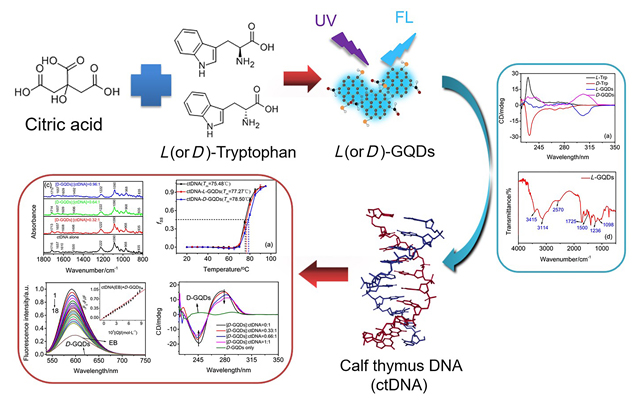摘要/Abstract

手性作为自然界最重要的特性之一,与生命活动息息相关.因此,手性纳米材料在材料学及生物学相关领域的研究引起了极大的关注.本工作提出了一种采用一步水热法合成手性石墨烯量子点的新方法.该方法以柠檬酸和L-色氨酸为原料进行手性石墨烯量子点的合成,通过圆二色光谱法证明了两种手性石墨烯量子点具有两个对称性高的手性信号,圆二色吸收峰分别位于230 nm和305 nm.通过荧光光谱法获取了它们与ctDNA相互作用的系列热力学参数,采用粘度测量、DNA熔链温度实验并结合多种谱学方法证明,手性石墨烯量子点与小牛胸腺DNA(ctDNA)之间的结合存在较大的手性差异.紫外-可见吸收光谱证明手性石墨烯量子点均能使ctDNA的吸收峰红移,并出现减色效应.手性石墨烯量子点提高了ctDNA的熔链温度,但降低了ctDNA的相对粘度.通过氢键和范德华力相互作用,手性石墨烯量子点均插入ctDNA的G-C碱基对中,这严重影响了ctDNA的右手B型螺旋结构.因空间位阻效应不同,右手性石墨烯量子点比左手性石墨烯量子点更容易与右手B型螺旋的ctDNA结合,且对ctDNA的右手B型螺旋结构产生显著的影响.这些结论阐明了手性石墨烯量子点与ctDNA之间嵌插结合作用的分子机制,为手性纳米材料在化学、生物学、医学等许多科学领域的发展提供有价值的信息.
关键词: 手性石墨烯量子点, 小牛胸腺DNA, 光谱法, 作用机理, 热力学参数, 空间位阻
As one of the most important characteristics of nature, chirality is closely related to life activities. Therefore, chiral nanomaterials have caused great attention in material, biology and some related fields. In this paper, a new preparation method for chiral graphene quantum dots (L-GQDs and D-GQDs) was proposed via one-step hydrothermal method. This method used citric acid and L(or D)-tryptophan as raw materials to synthesize chiral graphene quantum dots. Circular dichroism spectroscopy proved that the two chiral graphene quantum dots had two chiral signals with high symmetry, and the absorption peaks were located at 230 nm and 305 nm, respectively. A lot of thermodynamic parameters have been obtained by using fluorescence. The results of viscosity measurement, DNA melting experiments and multi-spectroscopic methods indicated that there was a large chiral difference between the combination of chiral graphene quantum dots and ctDNA. UV-Vis absorption spectrometry proved that the two different chiral graphene quantum dots caused the slightly red shift of absorption peak and hypochromic effect of ctDNA. These quantum dots increased the melting temperature of DNA, but reduced the relative viscosity of ctDNA. Through hydrogen bonding and van der Waals interaction, both graphene quantum dots were inserted into the G-C base pair of ctDNA, which affected the right-handed B-form helicity of ctDNA significantly. The steric hindrance effects of L-GQDs and D-GQDs were different, resulting in the differences of them in their intercalation and binding with ctDNA. Comparably, D-GQDs with right-handedness exhibited the strongest intercalative binding ability with ctDNA, and were easier to intercalate into ctDNA with the right-handed B-helical structure, causing the significant influence on right-handed B-helical structure of ctDNA. These results revealed the molecular mechanisms of the intercalative binding interactions between chiral graphene quantum dots and DNA, which provided valuable information for the development of chiral nanomaterials in chemistry, biology, and medicine areas.
Key words: chiral graphene quantum dot, calf thymus DNA, spectroscopy, interaction mechanism, thermodynamic parameter, steric hindrance
PDF全文下载地址:
点我下载PDF
